Large landing ships of the Russian fleet
This ship has a displacement of about 14 thousand tons with a draft of 5 meters and is able to carry onboard up to 8 helicopters Ka-52K and Ka-27 (29). The landing ship will be able to reach speeds up to 20 nodes, and its cruising range will be 6 thousands of miles, the autonomy of the cruise will be 60 days. The length of the ship will be 165 meters, width - 25 meters. The universal landing ship of the project “Surf” will be able to carry on board up to 40-60 units of various equipment and up to 500 paratroopers. UDC will be able to take on board four landing boats of the 11770M project or two boats of the 12061М project. At the same time, its air defense will be built on the basis of the Pantsir-M sea-based air defense missile system.
Construction of the first ship of the series is scheduled to begin as early as 2016, reports RIA "News"With reference to its source. At the same time, information appeared earlier that the Russian fleet would receive a new landing ship of a new generation by the 2020 year. About this in June 2015, said Vladimir Tryapichnikov, head of the shipbuilding department of the Russian Navy. According to him, the new ship will be several times larger in displacement than the BDK “Ivan Gren” (displacement of about 5 thousand tons), apparently Tryapichnikov spoke then about the UDC of the project “Surf”. Presumably, for the needs of the Russian Navy, an 4 ship of this type will be built.
It should be noted that the UDC of the Priboy project fits perfectly into the look of a modern landing craft. According to its main characteristics, it will approximately correspond to the main parameters of the universal landing craft of Holland of the type “Rotterdam” or “Johan de Witt”, which were chosen as samples. These warships also have a displacement of 14-16 thousand tons, are able to carry up to 500-600 marines and carry on board 6 helicopters and the necessary set of floating landing craft.
However, the Surf project ship is the future of the Russian fleet, this project has reached only the stage of the layout, and until its construction and adoption it can take quite a long time. Below we will consider the large landing ships that the Russian Navy will actually have or will soon have (Ivan Gren BDK should be accepted by the end of 2015).
BDK project 1171 "Tapir"
The large landing ship (BDK) of the ocean zone of the 1171 project (the cipher "Tapir", according to the NATO codification "Alligator") is intended for disembarking naval assault forces with military equipment on an unequipped coast with a small slope of the bottom, as well as the transfer of cargo and troops by sea. The ship is able to make landing amphibious units directly to the coast, and the floating equipment can be lowered into the water. The lead ship of this project, the Voronezh Komsomol member, was laid on February 5 1964 of the year on the stocks of the Baltic Shipbuilding Plant No. 820 Yantar in Kaliningrad. The ship was launched on July 1 1964 of the year. With all its shortcomings, it was the first in the Soviet Union BDK, which with the expeditionary battalion of marines on board could serve for a while in remote areas of the world’s ocean. For ten years from 1964 to 1974, the year in the USSR 14 ships of this project were built, which were produced in four different versions. For almost 20 years, the 1171 project ships formed the basis of the strategic landing forces of the USSR.
The ship had a total displacement of 4650 tons, the draft was 4,5 meters, length - 113,1 meters, width - 15,6 meters. The full speed of the BDK project "Tapir" was 16,5 nodes. The cruising range was 4,8 thousands of miles (approximately 8,9 thousands of kilometers). The autonomy of a large amphibious assault ship in terms of reserves of supplies and fuel (without replenishing it during a cruise) for the first ships of the series was 10 days, for subsequent ships - 20 days.
The landing device of the ship includes a nasal gate with a ramp, as well as a folding sealed lazport, located at the stern. Loading on the ship equipment can be made under its own power through the feed or bow landing device. For loading cargo on the upper deck or through the hatches in the twin deck on the ship there are special cranes. The landing of the landing force from the ship can be carried out afloat, and the non-floating equipment lands directly on the coast, while the minimum bottom slope should be 2-3 degrees (depending on the mass of cargo taken on board the ship). Above all, the BDK project 1171 could be used to transport ammunition, as well as to transport missiles in containers.
The power plant of the ship is diesel, it consists of two power units with 4,5 power, thousands of horsepower each (engine models differed depending on the ship version). The armament could also be different and consisted of a twin-mounted universal naval artillery mount ZIF-31B caliber 57-mm and two twin 25-mm guns 2М-3. Also on the ship were mounted two installations of the Grad-M multiple rocket launcher system designed to support the landing force. For air defense were supposed to be used MANPADS "Strela-3".
Project 1171 BDK could take on board up to 20 main combat tanks, about 45 armored personnel carriers, or 50 trucks and 300 to 400 troops. Members of the landing were located in two cockpits under the first and fourth twindeks. In addition, the ship could be used to transport goods, taking on board up to 1000 tons of various cargoes. In the bow of the ship was a compartment for armored vehicles, there was also a ramp closed by sliding gates. In the stern of the ship for loading and unloading operations was equipped with a folding lapport. The crew of the ship consisted of 69 people, including 5 officers (the crew of 83 people, including 7 officers and 11 midshipmen for the BDK Nikolai Vilkov, Pacific Fleet, 1990s). According to information from open sources, currently the Russian Navy has 4 BDKs of Project 1171 in service: 3 ships in the Black Sea Fleet and one ship in the Pacific Fleet.
BDK project 1174 "Rhino"
The BDK of the ocean zone of the 1174 project (cipher "Rhino", according to the NATO codification of Ivan Rogov) was designed to transport and disembark landing troops and military equipment both on the equipped and on the unequipped coast with a small slope of the bottom. The ship is able to land troops directly on the coast, floating equipment - on the water, non-swimming military equipment - with the help of special landing-landing craft, personnel of the landing with a portable weapons can also be landed ashore by helicopter.
In the course of the ship design work, on the orders of the Soviet Navy Commander-in-Chief S. G. Gorshkov, changes were made to the project, which ultimately led to the creation of a very original universal amphibious ship with a relatively small displacement. As a result of changes to the project, a dock chamber appeared on the ship, and the composition of the crew on board was increased. Changes to the project in the course of the work were made under the impression of the US Navy's program for construction of the Tarava-type UDC that is under way. In the course of all the improvements, coastal accessibility for the BNC project 1174 has become: for the bow gangway - 17%, for landing craft - more than 40%, for helicopters - 100%.
The ships of this project were built in the USSR from 1973 to 1988, in total, three such ships were built. The ships were laid and built in Kaliningrad at the Baltic Shipbuilding Plant No. XXUMX Yantar. Due to the constant changes in the project of the head ship of the series “Ivan Rogov” was ready only in the 820 year, after 1978 years after the issue of the technical specification for its design. In total, three such vessels were built in Kaliningrad: “Ivan Rogov” (14 year), “Alexander Nikolaev” (1978 year) and “Mtrofan Moskalenko” (1982 year). The first ship was decommissioned from the fleet in 1990. The other two were sent to the reserve in 1996 and 1997 respectively. After stories with the "Mistrals" in the press appeared information about the study of the issue of restoring ships and returning them to the Russian Navy.
The length of the ship project 1174 cipher "Rhino" was 157,5 meters, width - 23,8 meters, draft - 5 meters. The ship’s total displacement was 14 060 tons. Full speed - 21 knot, cruising range at 18 knots and a normal 4 fuel reserve is thousands of miles, with a maximum fuel reserve of 7500 miles. The power plant of the ship was a gas turbine and included two power units with 18 thousand horsepower each. each. The autonomy of the provisions reserves was 15 days when the paratroopers were on board the 500 or 30 days when the landing party was on the 250. The crew of the ship was 239 people, including 37 officers. To receive liquid and solid cargoes into the sea, the ship was equipped with special systems.
The armament of the ships varied depending on the modification and consisted of an AK-726 X-gun caliber of 76,2-mm caliber, two AK-630 6-XXMX-mm artillery mounts, two Grad-M rocket launcher systems, one SAM 30 missiles) and four Strela-20 MANPADS. On board the ship could be based up to X-NUMX transport helicopters Ka-3.
In the tank hold, the BDK and the dock chamber in the absence of swimming facilities in it could be loaded up to 50 PT-76, 80 BTR and BMP tanks, or to 120 vehicles. In this case, the equipment could be loaded on board in various combinations. Also on board it was possible to place up to 500 people of assault forces in several cockpits and four-seater officer cabins, or to place 1700 tons of various cargoes. For unloading of non-floating combat vehicles to the shore into the ship’s dock chamber, it was possible to receive up to 6 landing craft of the 1785 project or 1176 project. Either three landing hovercraft of the 1206 project or landing boats on the 11770 "Serna" air cavern.
BDK project 775
BDK project 775 for the needs of the Soviet fleet were built in Poland at the shipyard Stocznia Polnocna (Stochnja Polnochna), in the city of Gdansk. The ships were built from 1974 to 1991 years, in total there were built 28 ships of this project in three different versions. Initially, they were classified as medium landing ships (KFOR), but in 1977, they were retrained in the BDK. Currently, the ships of this project are the most massive BDK of the Russian fleet, forming the basis of the Russian amphibious fleet. The 15 ships of this type remain in service, and taking into account the Ukrainian BDK Konstantin Olshansky captured in 2014 by the Russian military, the 16.
Landing craft project 775 created to replace the BDK project 1171. The new ship was supposed to receive more powerful weapons and improved survivability, unlike the 1171 project, which was made on the basis of the bulk carrier. The ships of the 775 project were initially designed as a ship specially designed for amphibious operations. They were to occupy an intermediate position between the "Rhino" and KFOR. BDK project 775 have a length of 112,5 meters, width - 15 meters, draft - 4,26 meters, the ship's total displacement is 4400 tons. Full speed - 17,6 knots, cruising range up to 4 thousands of miles (about 7,4 thousands of kilometers), navigation autonomy - up to 30 days. As a power plant, two Zgoda-Sulzer diesel engines were used, developing 9,6 ths. Horsepower. each.
The armament of the ships of this project was different depending on the modifications. Initially, it was planned to install two twin guns of caliber 57-mm AK-725 with remote guidance. To increase firepower and air defense systems, an 775-mm AK-76,2 artillery mount and two AK-176М 630-X6-mm artillery were installed on ships of the 30М project. To suppress the coastal defense of the enemy and destroy its manpower, two launchers of the MLRS Grad-M were installed on the landing craft of the 775 project. The Strela-3 and Igla systems could be used as air defense weapons.
The ships of the 775 project were originally calculated on the transportation by sea of a reinforced company of marines or 225 paratroopers and 10 tanks. The dimensions of the cargo compartment are 95х4,5х4,5 meters, and the ship could also take on board up to 480 tons of various cargoes. The paratroopers were located in several cabins, and the officers were in four-bed cabins. The crew of the ship was 98 people, including 8 officers.
BDK project 11711 "Ivan Gren"
The large landing ships of the 11711 project (according to the NATO codification of Ivan Gren) is a project of the new BDK of the Russian fleet, intended for the landing of troops, transportation of goods, military equipment and equipment. This landing ship is a further development of the ships of the 1171 "Tapir" project, while most of the ship design has undergone major changes. 11 June 2015 of the year at the Yantar Baltic Shipbuilding Plant in Kaliningrad, a groundbreaking ceremony was held for the second BDK project 11711 “Peter Morgunov”. The lead ship of the Ivan Gren series was laid at the Kaliningrad plant in December 2004, the ship was launched in May 2012, the transfer of the ship to the military is scheduled for 2015 year. In total, up to 2020, the Russian Navy should have received 6 ships of this type.
When creating a ship, much attention was paid to the conditions of crew and landing forces on it. The loading of military equipment onto a ship is possible in two ways: independently using a ramp, or using a port or deck cargo crane through a four-wing cargo hatch located in the upper deck. These hatches also allow you to ventilate the underdeck space when, just before the landing, the combat vehicles start the engines operating at idle speed, which leads to the filling of the landing space with exhaust gases. For loading and unloading operations in the cargo hatch area, the vessel has a crane with a lifting capacity of 16 tons and two boat cranes, designed to work with motor boats and lifeboats.
The total displacement of the BDK "Ivan Gren" is 5000 tons, which makes it the largest among all the BDK of the Russian fleet in service at the given time. Full speed is 18 knots, cruising range is up to 3500 nautical miles with 16 knots speed. The autonomy of swimming is up to 30 days. The crew of the ship consists of 100 people. The combat equipment is located on the tank deck inside the BDK; these can be either main battle tanks weighing up to 60 tons (13 tanks), or BMP and BTR (up to 36 units), or 300 landing troops.
Of the weapons on board the ship are two launchers of the MLRS Grad-M, two AK-630М 6х30-mm artillery mounts, and AK-176 universal artillery mounts of the 76,2 mm caliber. In addition, the ship provides for the basing of one transport-combat helicopter Ka-29. According to some information, the Igla-V complex can be used as an air defense weapon.
Information sources:
http://tass.ru/armiya-i-opk/2028399
http://lenta.ru/news/2015/06/16/priboy
http://www.rg.ru/2015/06/16/analog-site.html
http://navalcadet.narod.ru
http://www.shipyard-yantar.ru/ru/press/265-zalozhitbdk.html
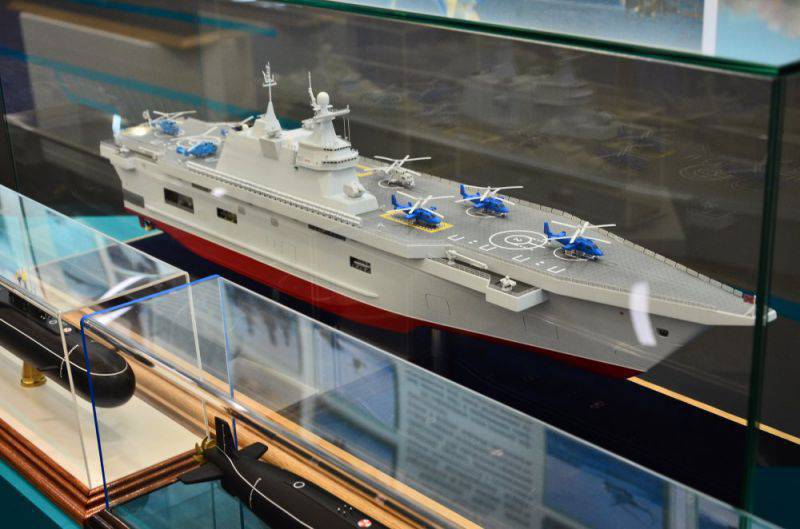
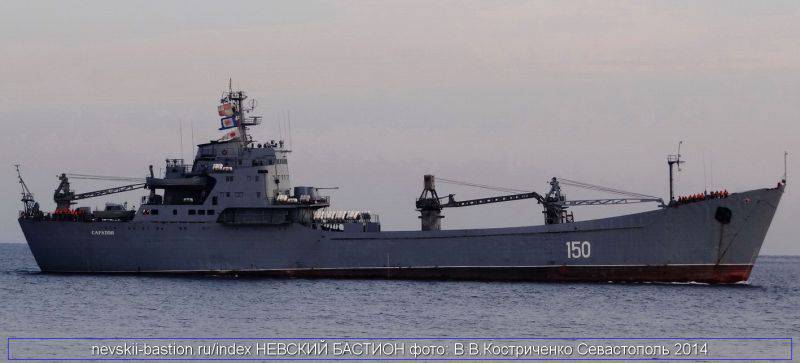
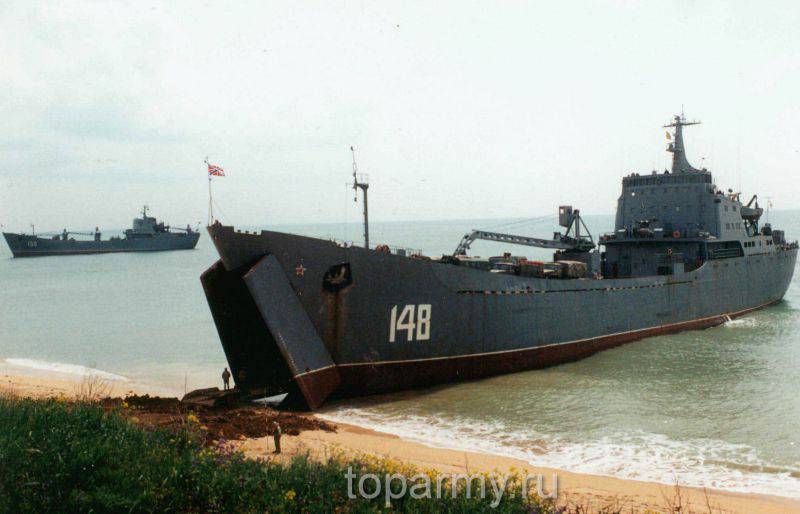
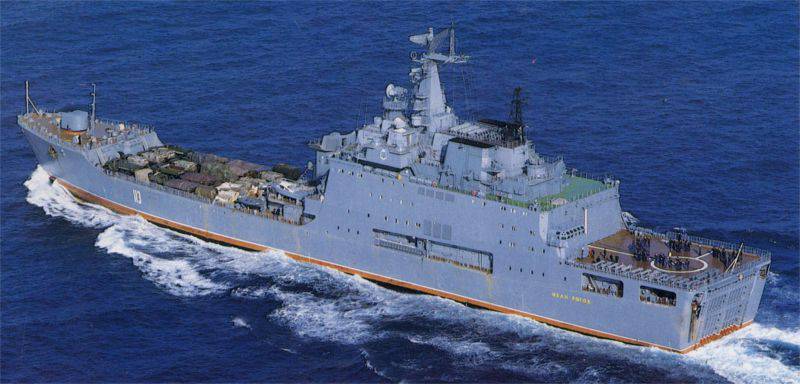
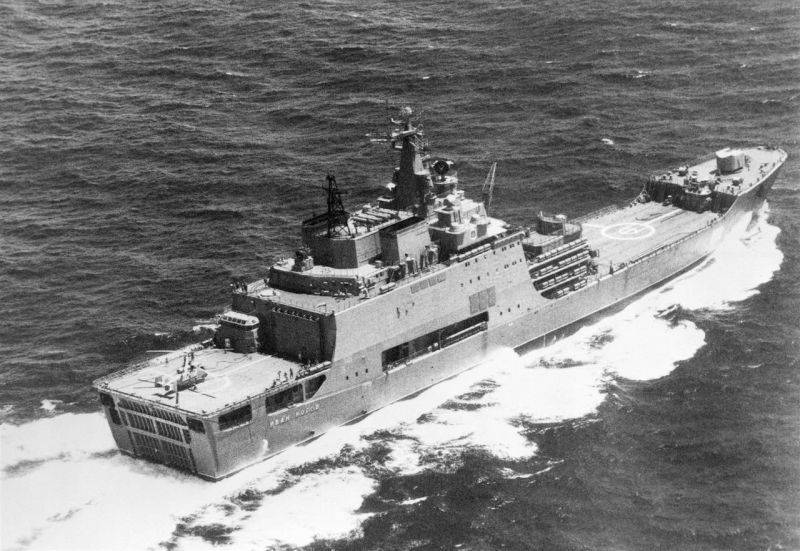
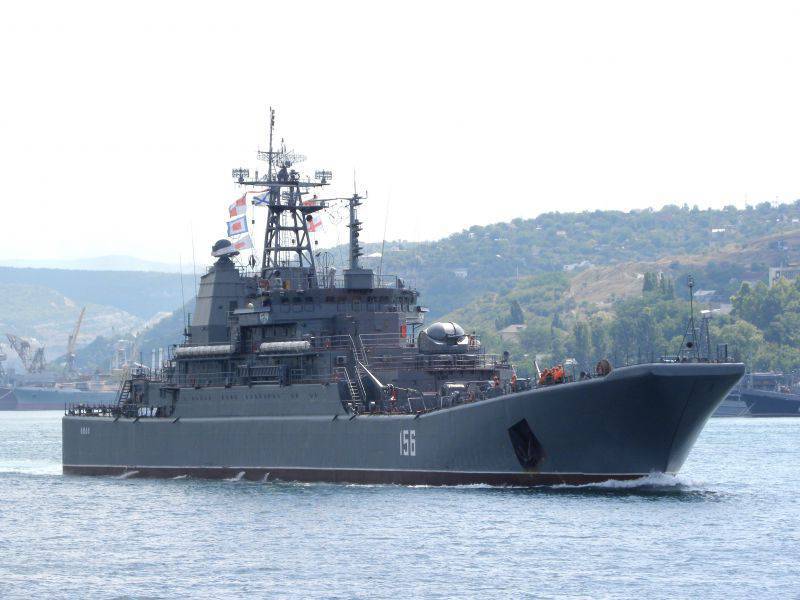
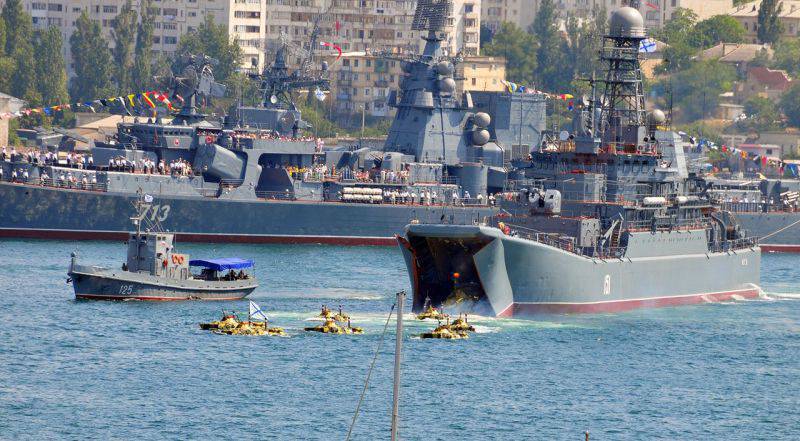
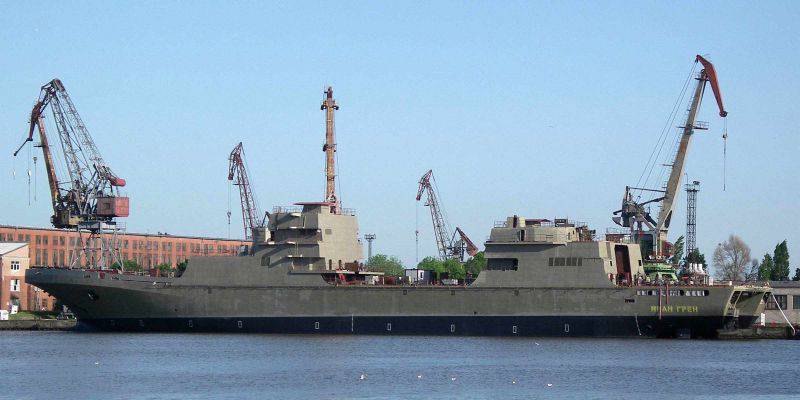
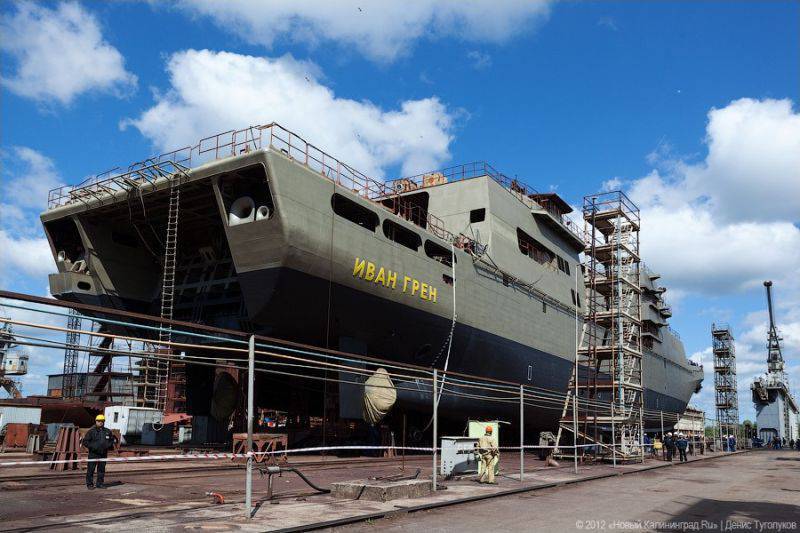
Information